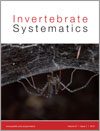IS11047Phylogeny and revision of the New World seed-feeding bruchine genus Gibbobruchus Pic (Coleoptera : Chrysomelidae)
The taxonomic position of the seed beetles (Chrysomelidae: Bruchinae: Gibbobruchus) is historically controversial. A test of the monophyly of Gibbobruchus, a cladistic analysis based on external adult morphological characters, confirmed that the genus is monophyletic and supported by several synapomorphies. This work improves our understanding of one of the largest lineages of plant-feeding insects.




